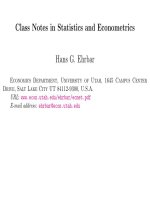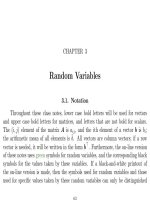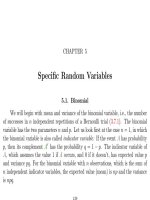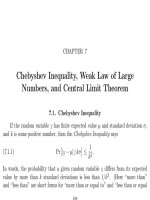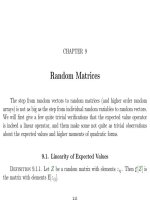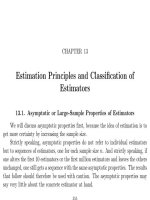Class Notes in Statistics and Econometrics Part 7 ppt
Bạn đang xem bản rút gọn của tài liệu. Xem và tải ngay bản đầy đủ của tài liệu tại đây (557.54 KB, 70 trang )
CHAPTER 13
Estimation Principles and Classification of
Estimators
13.1. Asymptotic or Large-Sample Properties of Estimators
We will discuss asymptotic properties first, because the idea of estimation is to
get more certainty by increasing the sample size.
Strictly speaking, asymptotic prop e rties do not refer to individual estimators
but to sequences of estimators, one for each sample size n. And strictly speaking, if
one alters the first 10 estimators or the first million estimators and leaves the others
unchanged, one still gets a sequence w ith the same asymptotic properties. The results
that follow should therefore be used with caution. The asymptotic properties may
say very little about the concrete estimator at hand.
355
356 13. ESTIMATION PRINCIPLES
The most basic asymptotic property is (weak) consistency. An estimator t
n
(where n is the sample size) of the parameter θ is consistent iff
(13.1.1) plim
n→∞
t
n
= θ.
Roughly, a consistent estimation procedure is one which gives the correct parameter
values if the sample is large enough. There are only very few exceptional situations
in which an estimator is acceptable which is not consistent, i.e., which does not
converge in the plim to the true parameter value.
Problem 194. Can you think of a situation where an estimator which is not
consistent is acceptable?
Answer. If additional data no longer give information, like when estimating the initial state
of a timeseries, or in prediction. And if there is no identification but the value can be confined to
an interval. This is also inconsistency.
The following is an important property of consistent estimators:
Slutsky theorem: If t is a consistent estimator for θ, and the function g is con-
tinuous at the true value of θ, then g(t) is consistent for g(θ).
For the proof of the Slutsky theorem remember the definition of a continuous
function. g is continuous at θ iff for all ε > 0 there exists a δ > 0 with the property
that for all θ
1
with |θ
1
− θ| < δ follows |g(θ
1
) −g(θ)| < ε. To prove consistency of
13.1. ASYMPTOTIC PROPERTIES 357
g(t) we have to show that for all ε > 0, Pr[|g(t) −g(θ)| ≥ ε] → 0. Choose for the
given ε a δ as above, then |g(t) −g(θ)| ≥ ε implies |t −θ| ≥ δ, because all those
values of t for with |t −θ| < δ lead to a g(t) with |g(t) −g(θ)| < ε. This logical
implication means that
(13.1.2) Pr[|g(t) −g(θ)| ≥ ε] ≤ Pr[|t −θ| ≥ δ].
Since the probability on the righthand side converges to zero, the one on the lefthand
side converges too.
Different consistent estimators can have quite different speeds of convergence.
Are there estimators which have optimal asymptotic properties among all consistent
estimators? Yes, if one limits oneself to a fairly reasonable subclass of consistent
estimators.
Here are the details: Most consistent estimators we will encounter are asymp-
totically normal, i.e., the “shape” of their distribution function converges towards
the normal distribution, as we had it for the sample mean in the central limit the-
orem. In order to be able to use this asymptotic distribution for significance tests
and confidence intervals, however, one needs more than asymptotic normality (and
many textbo oks are not aware of this): one needs the convergence to normality to
be uniform in compact intervals [Rao73, p. 346–351]. Such estimators are called
consistent uniformly asymptotically normal estimators (CUAN estimators)
358 13. ESTIMATION PRINCIPLES
If one limits oneself to CUAN estimators it can be shown that there are asymp-
totically “best” CUAN estimators. Since the distribution is asymptotically normal,
there is no problem to define what it means to be asymptotically best: those es-
timators are asymptotically best whose asymptotic MSE = asymptotic variance is
smallest. CUAN estimators whose MSE is asymptotically no larger than that of
any other CUAN estimator, are called asymptotically efficient. Rao has shown that
for CUAN estimators the lower bound for this asymptotic variance is the asymptotic
limit of the Cramer Rao lower bound (CRLB). (More about the CRLB below). Max-
imum likelihood estimators are therefore usually efficient CUAN estimators. In this
sense one can think of maximum likelihood estimators to be something like asymp-
totically best consistent estimators, compare a statement to this effect in [Ame94, p.
144]. And one can think of asymptotically efficient CUAN estimators as estimators
who are in large samples as good as maximum likelihood estimators.
All these are large sample properties. Among the asymptotically efficient estima-
tors there are still wide differences regarding the small sample properties. Asymptotic
efficiency should therefore again be considered a minimum requirement: there must
be very good reasons not to be working with an asymptotically efficient estimator.
Problem 195. Can you think of situations in which an estimator is acceptable
which is not asymptotically efficient?
13.2. SMALL SAMPLE PROPERTIES 359
Answer. If robustness matters then the median may be preferable to the mean, although it
is less efficient.
13.2. Small Sample Properties
In order to judge how good an estimator is for small samples, one has two
dilemmas: (1) there are many different criteria for an estimator to b e “good”; (2)
even if one has decided on one criterion, a given estimator may be good for some
values of the unknown parameters and not so good for others.
If x and y are two estimators of the parameter θ, then each of the following
conditions can be interpreted to mean that x is better than y:
Pr[|x −θ| ≤ |y − θ|] = 1(13.2.1)
E[g(x −θ)] ≤ E[g(y − θ)](13.2.2)
for every continuous function g which is and nonincreasing for x < 0 and nondecreas-
ing for x > 0
E[g(|x −θ|)] ≤ E[g(|y − θ|)](13.2.3)
360 13. ESTIMATION PRINCIPLES
for every continuous and nondecreasing function g
Pr[{|x −θ| > ε}] ≤ Pr[{|y −θ| > ε}] for every ε(13.2.4)
E[(x −θ)
2
] ≤ E[(y −θ)
2
](13.2.5)
Pr[|x −θ| < |y − θ|] ≥ Pr[|x − θ| > |y −θ|](13.2.6)
This list is from [Ame94, pp. 118–122]. But we will simply use the MSE.
Therefore we are left with dilemma (2). There is no single estimator that has
uniformly the smallest MSE in the sense that its MSE is better than the MSE of
any other estimator whatever the value of the parameter value. To s ee this, simply
think of the following estimator t of θ: t = 10; i.e., whatever the outcome of the
experiments, t always takes the value 10. This estimator has zero MSE when θ
happ e ns to be 10, but is a bad estimator when θ is far away from 10. If an estimator
existed which had uniformly best MSE, then it had to be better than all the constant
estimators, i.e., have zero MSE whatever the value of the parameter, and this is only
possible if the parameter itself is observed.
Although the MSE criterion cannot be used to pick one best estimator, it can be
used to rule out estimators which are unnecessarily bad in the sense that other esti-
mators exist which are never worse but sometimes better in terms of MSE whatever
13.2. SMALL SAMPLE PROPERTIES 361
the true parameter values. Estimators which are dominated in this sense are called
inadmissible.
But how can one choose between two admissible estimators? [Ame94, p. 124]
gives two reasonable strategies. One is to integrate the MSE out over a distribution
of the likely values of the parameter. This is in the spirit of the Bayesians, although
Bayesians would still do it differently. The other strategy is to choose a minimax
strategy. Amemiya seems to consider this an alright strategy, but it is really too
defensive. Here is a third strategy, which is often used but less well founded theoreti-
cally: Since there are no estimators which have minimum MSE among all estimators,
one often looks for estimators which have minimum MSE among all estimators with
a certain property. And the “certain property” which is most often used is unbiased-
ness. The MSE of an unbiased estimator is its variance; and an estimator which has
minimum variance in the class of all unbiased estimators is called “efficient.”
The class of unbiased estimators has a high-sounding name, and the results
related with Cramer-Rao and Least Squares seem to confirm that it is an important
class of estimators. However I will argue in these class notes that unbiasedness itself
is not a desirable property.
362 13. ESTIMATION PRINCIPLES
13.3. Comparison Unbiasedness Consistency
Let us compare consistency with unbiasedness. If the estimator is unbiased,
then its expected value for any sample size, whether large or small, is equal to the
true parameter value. By the law of large numbers this can be translated into a
statement about large samples: The mean of many independent replications of the
estimate, even if each replication only uses a small number of observations, gives
the true parameter value. Unbiasedness says therefore something about the small
sample properties of the estimator, while consistency does not.
The following thought experiment may clarify the difference between unbiased-
ness and consistency. Imagine you are conducting an expe riment which gives you
every ten seconds an independent measurement, i.e., a measurement whose value is
not influenced by the outcome of previous measurements. Imagine further that the
experimental setup is connected to a computer which estimates certain parameters of
that experiment, re-calculating its estimate every time twenty new observation have
become available, and which displays the current values of the estimate on a screen.
And assume that the estimation procedure used by the computer is consistent, but
biased for any finite number of observations.
Consistency means: after a sufficiently long time, the digits of the parameter
estimate displayed by the computer will be correct. That the estimator is biased,
means: if the computer were to use every batch of 20 observations to form a new
13.3. COMPARISON UNBIASEDNESS CONSISTENCY 363
estimate of the parameter, without utilizing prior observations, and then would use
the average of all these independent estimates as its updated estimate, it would end
up displaying a wrong parameter value on the screen.
A biased extimator gives, even in the limit, an incorrect result as long as one’s
updating procedure is the simple taking the averages of all previous estimates. If
an estimator is biased but consistent, then a better updating method is available,
which will end up in the correct parameter value. A biased estimator therefore is not
necessarily one which gives incorrect information about the parameter value; but it
is one which one cannot update by simply taking averages. But there is no reason to
limit oneself to such a crude method of updating. Obviously the question whether
the estimate is biased is of little relevance, as long as it is consistent. The moral of
the story is: If one looks for desirable estimators, by no means should one restrict
one’s search to unbiased estimators! The high-sounding name “unbiased” for the
technical property E[t] = θ has created a lot of confusion.
Besides having no advantages, the category of unbiasedness even has some in-
convenient properties: In some cases, in which consistent estimators exist, there are
no unbiased estimators. And if an estimator t is an unbiased estimate for the pa-
rameter θ, then the estimator g(t) is usually no longer an unbiased estimator for
g(θ). It depends on the way a certain quantity is measured whether the estimator is
unbiased or not. However consistency carries over.
364 13. ESTIMATION PRINCIPLES
Unbiasedness is not the only possible criterion which ensures that the values of
the estimator are centered over the value it estimates. Here is another plausible
definition:
Definition 13.3.1. An estimator
ˆ
θ of the scalar θ is called median unbiased for
all θ ∈ Θ iff
(13.3.1) Pr[
ˆ
θ < θ] = Pr[
ˆ
θ > θ] =
1
2
This concept is always applicable, even for estimators whose expected value does
not exist.
Problem 196. 6 points (Not eligible for in-class exams) The purpose of the fol-
lowing problem is to show how restrictive the requirement of unbiasedness is. Some-
times no unbiased estimators exist, and sometimes, as in the example here, unbiased-
ness leads to absurd estimators. Assume the random variable x has the geometric
distribution with parameter p, where 0 ≤ p ≤ 1. In other words, it can only assume
the integer values 1, 2, 3, . . ., with probabilities
(13.3.2) Pr[x = r] = (1 − p)
r−1
p.
Show that the unique unbiased estimator of p on the basis of one observation of x is
the random variable f(x) defined by f(x) = 1 if x = 1 and 0 otherwise. Hint: Use
13.3. COMPARISON UNBIASEDNESS CONSISTENCY 365
the mathematical fact that a function φ(q) that can be expressed as a power series
φ(q) =
∞
j=0
a
j
q
j
, and which takes the values φ(q) = 1 for all q in some interval of
nonzero length, is the power series with a
0
= 1 and a
j
= 0 for j = 0. (You will need
the hint at the end of your answer, don’t try to start with the hint!)
Answer. Unbiasedness means that E[f(x)] =
∞
r=1
f(r)(1 − p)
r−1
p = p for all p in the unit
interval, therefore
∞
r=1
f(r)(1 − p)
r−1
= 1. This is a power series in q = 1 − p, which must be
identically equal to 1 for all values of q between 0 and 1. An application of the hint shows that
the constant term in this power series, corresponding to the value r − 1 = 0, must be = 1, a nd all
other f(r) = 0. Here older formulation: An application of the hint with q = 1 − p, j = r −1, and
a
j
= f(j + 1) gives f(1) = 1 and all other f(r) = 0. This estimator is absurd since it lies on the
boundary of the range of possible values for q.
Problem 197. As in Question 61, you make two independent trials of a Bernoulli
experiment with success probability θ, and you observe t, the number of successes.
• a. Give an unbiased estimator of θ based on t (i.e., w hich is a function of t).
• b. Give an unbiased estimator of θ
2
.
• c. Show that there is no unbiased estimator of θ
3
.
Hint: Since t can only take the three values 0, 1, and 2, any estimator u which
is a function of t is determined by the values it takes when t is 0, 1, or 2, call them
u
0
, u
1
, and u
2
. Express E[u] as a function of u
0
, u
1
, and u
2
.
366 13. ESTIMATION PRINCIPLES
Answer. E[u] = u
0
(1 −θ)
2
+ 2u
1
θ(1 −θ)+u
2
θ
2
= u
0
+ (2u
1
−2u
0
)θ +(u
0
−2u
1
+ u
2
)θ
2
. This
is always a second degree polynomial in θ, therefore whatever is not a second degree polynomial in θ
cannot be the expected value of any function of t. For E[u] = θ we need u
0
= 0, 2u
1
−2u
0
= 2u
1
= 1,
therefore u
1
= 0.5, and u
0
−2u
1
+ u
2
= −1 + u
2
= 0, i.e. u
2
= 1. This is, in other words, u = t/2.
For E[u] = θ
2
we need u
0
= 0, 2u
1
−2u
0
= 2u
1
= 0, therefore u
1
= 0, and u
0
−2u
1
+ u
2
= u
2
= 1,
This is, in other words, u = t(t −1)/2. From this equation one also sees that θ
3
and higher powers,
or thing s like 1/θ, cannot be the expected values of any estimators.
• d. Compute the moment generating function of t.
Answer.
(13.3.3) E[e
λt
] = e
0
· (1 − θ)
2
+ e
λ
· 2θ(1 − θ) + e
2λ
· θ
2
=
1 − θ + θe
λ
2
Problem 198. This is [KS79, Question 17.11 on p. 34], originally [Fis, p. 700].
• a. 1 point Assume t and u are two unbiased estimators of the same unknown
scalar nonrandom parameter θ. t and u have finite variances and satisfy var[u −t] =
0. Show that a linear combination of t and u, i.e., an estimator of θ which can be
written in the form αt + βu, is unbiased if and only if α = 1 −β. In other words,
any unbiased estimator which is a linear combination of t and u can be written in
the form
(13.3.4) t + β(u −t).
13.3. COMPARISON UNBIASEDNESS CONSISTENCY 367
• b. 2 points By solving the first order condition show that the unbiased linear
combination of t and u which has lowest MSE is
(13.3.5)
ˆ
θ = t −
cov[t, u −t]
var[u − t]
(u −t)
Hint: your arithmetic will be simplest if you start with (13.3.4).
• c. 1 point If ρ
2
is the squared correlation coefficient between t and u −t, i.e.,
(13.3.6) ρ
2
=
(cov[t, u −t])
2
var[t] var[u −t]
show that var[
ˆ
θ] = var[t](1 −ρ
2
).
• d. 1 point Show that cov[t, u −t] = 0 implies var[u −t] = 0.
• e. 2 points Use (13.3.5) to show that if t is the minimum MSE unbiased
estimator of θ, and u another unbiased estimator of θ, then
(13.3.7) cov[t, u −t] = 0.
• f. 1 point Use (13.3.5) to show also the opposite: if t is an unbiased estimator
of θ with the property that cov[t, u −t] = 0 for every other unbiased estimator u of
θ, then t has minimum MSE among all unbiased estimators of θ.
368 13. ESTIMATION PRINCIPLES
There are estimators which are consistent but their bias does not converge to
zero:
(13.3.8)
ˆ
θ
n
=
θ with probability 1 −
1
n
n with probability
1
n
Then Pr(
ˆ
θ
n
− θ
≥ ε) ≤
1
n
, i.e., the estimator is consistent, but E[
ˆ
θ] = θ
n−1
n
+ 1 →
θ + 1 = 0.
Problem 199. 4 points Is it possible to have a consistent estimator whose bias
becomes unbounded as the sample size increases? Either prove that it is not possible
or give an example.
Answer. Yes, this can be achieved by making the rare outliers even wilder than in (13.3.8),
say
(13.3.9)
ˆ
θ
n
=
θ with p robab ility 1 −
1
n
n
2
with p robab ility
1
n
Here Pr(
ˆ
θ
n
− θ
≥ ε) ≤
1
n
, i.e., the estimator is consistent, but E[
ˆ
θ] = θ
n−1
n
+ n → θ + n.
And of course there are estimators which are unbiased but not consistent: sim-
ply take the first observation x
1
as an estimator if E[x] and ignore all the other
observations.
13.4. THE CRAMER-RAO LOWER BOUND 369
13.4. The Cramer-Rao Lower Bound
Take a scalar random variable y with density function f
y
. The entropy of y, if it
exists, is H[y] = −E[log(f
y
(y))]. This is the continuous equivalent of ( 3.11.2). The
entropy is the measure of the amount of randomness in this variable. If there is little
information and much noise in this variable, the entropy is high.
Now let y → g(y) be the density function of a different random variable x. In
other words, g is some function which satisfies g(y) ≥ 0 for all y, and
+∞
−∞
g(y) dy = 1.
Equation (3.11.10) with v = g(y) and w = f
y
(y) gives
(13.4.1) f
y
(y) −f
y
(y) log f
y
(y) ≤ g(y) −f
y
(y) log g(y).
This holds for every value y, and integrating over y gives 1 − E[log f
y
(y)] ≤ 1 −
E[log g(y)] or
(13.4.2) E[log f
y
(y)] ≥ E[log g(y)].
This is an important extremal value property which distinguishes the density function
f
y
(y) of y from all other density functions: That density function g which maximizes
E[log g(y)] is g = f
y
, the true density function of y.
This optimality property lies at the basis of the Cramer-Rao inequality, and it
is also the reason why maximum likelihood estimation is so good. The difference
370 13. ESTIMATION PRINCIPLES
between the left and right hand side in (13.4.2) is called the Kullback-Leibler dis-
crepancy between the random variables y and x (where x is a random variable whose
density is g).
The Cramer Rao inequality gives a lower bound for the MSE of an unbiased
estimator of the parameter of a probability distribution (which has to satisfy cer-
tain regularity conditions). This allows one to determine whether a given unbiased
estimator has a MSE as low as any other unbiased estimator (i.e., whether it is
“efficient.”)
Problem 200. Assume the density function of y depends on a parameter θ,
write it f
y
(y; θ), and θ
◦
is the true value of θ. In this problem we will compare the
expected value of y and of functions of y with wh at would be their expected value if the
true parameter value were not θ
◦
but would take some other value θ. If the random
variable t is a function of y, we write E
θ
[t] for what would be the expected value of t
if the true value of the parameter were θ instead of θ
◦
. Occasionally, we will use the
subscript ◦ as in E
◦
to indicate that we are dealing here with the usual case in which
the expected value is taken with respect to the true parameter value θ
◦
. Instead of E
◦
one usually simply writes E, since it is usually self-understood that one has to plug
the right parameter values into the density function if one takes expected values. The
subscript ◦ is necessary here only because in the present problem, we sometimes take
13.4. THE CRAMER-RAO LOWER BOUND 371
expected values with respect to the “wrong” parameter values. The same notational
convention also applies to variances, covariances, and the MSE.
Throughout this problem we assume that the following regularity conditions hold:
(a) the range of y is independent of θ, and (b) the derivative of the density function
with respect to θ is a continuous differentiable function of θ. These regularity condi-
tions ensure that one can differentiate under the integral sign, i.e., for all function
t(y) follows
∞
−∞
∂
∂θ
f
y
(y; θ)t(y) dy =
∂
∂θ
∞
−∞
f
y
(y; θ)t(y) dy =
∂
∂θ
E
θ
[t(y)](13.4.3)
∞
−∞
∂
2
(∂θ)
2
f
y
(y; θ)t(y) dy =
∂
2
(∂θ)
2
∞
−∞
f
y
(y; θ)t(y) dy =
∂
2
(∂θ)
2
E
θ
[t(y)].(13.4.4)
• a. 1 point The sc ore is defined as the random variable
(13.4.5) q(y; θ) =
∂
∂θ
log f
y
(y; θ).
In other words, we do three things to the density function: take its logarithm, then
take the derivative of this logarithm with respect to the parameter, and then plug the
random variable into it. This gives us a random variable which also depends on the
372 13. ESTIMATION PRINCIPLES
nonrandom parameter θ. Show that the score can also be written as
(13.4.6) q(y; θ) =
1
f
y
(y; θ)
∂f
y
(y; θ)
∂θ
Answer. This is the chain rule for differentiation: for any differentiable function g(θ),
∂
∂θ
log g(θ) =
1
g(θ)
∂g(θ)
∂θ
.
• b. 1 point If the density function is member of an exponential dispersion family
(6.2.9), show that the score function has the form
(13.4.7) q(y; θ) =
y −
∂b(θ)
∂θ
a(ψ)
Answer. This is a simple substitution: if
(13.4.8) f
y
(y; θ, ψ) = exp
yθ − b(θ)
a(ψ)
+ c(y, ψ)
,
then
(13.4.9)
∂ log f
y
(y; θ, ψ)
∂θ
=
y −
∂b(θ)
∂θ
a(ψ)
13.4. THE CRAMER-RAO LOWER BOUND 373
• c. 3 points If f
y
(y; θ
◦
) is the true density function of y, then we know from
(13.4.2) that E
◦
[log f
y
(y; θ
◦
)] ≥ E
◦
[log f(y; θ)] for all θ. This explains why the score
is so important: it is the derivative of that function whose expected value is maximized
if the true parameter is plugged into the density function. The first-order conditions
in this situation read: the expected value of this derivative must be zero for the true
parameter value. This is the next thing you are asked to show: If θ
◦
is the true
parameter value, show that E
◦
[q(y; θ
◦
)] = 0.
Answer. First write for general θ
E
◦
[q(y; θ)] =
∞
−∞
q(y; θ)f
y
(y; θ
◦
) dy =
∞
−∞
1
f
y
(y; θ)
∂f
y
(y; θ)
∂θ
f
y
(y; θ
◦
) dy.(13.4.10)
For θ = θ
◦
this sim plifie s:
E
◦
[q(y; θ
◦
)] =
∞
−∞
∂f
y
(y; θ)
∂θ
θ=θ
◦
dy =
∂
∂θ
∞
−∞
f
y
(y; θ) dy
θ=θ
◦
=
∂
∂θ
1 = 0.(13.4.11)
Here I am writing
∂f
y
(y;θ)
∂θ
θ=θ
◦
instead of the simpler notation
∂f
y
(y;θ
◦
)
∂θ
, in order to emphasize
that one first has to take a derivative with respect to θ and then one plugs θ
◦
into that derivative.
• d. Show that, in the case of the exponential dispersion family,
(13.4.12) E
◦
[y] =
∂b(θ)
∂θ
θ=θ
◦
374 13. ESTIMATION PRINCIPLES
Answer. Follows from the fact that the score function of the exponential family (13.4.7) has
zero expected value.
• e. 5 points If we differentiate the score, we obtain the Hes sian
(13.4.13) h(θ) =
∂
2
(∂θ)
2
log f
y
(y; θ).
From now on we will write the score function as q(θ) instead of q(y; θ); i.e., we will
no longer make it explicit that q is a function of y but write it as a random variable
which depends on the parameter θ. We also suppress the dependence of h on y; our
notation h(θ) is short for h(y; θ). Since there is only one parameter in the den sity
function, score and Hessian are scalars; but in the general case, the score is a vector
and the Hessian a matrix. Show that, for the true parameter value θ
◦
, the negative
of the expected value of the Hessian equals the variance of the score, i.e., the expected
value of the square of the score:
(13.4.14) E
◦
[h(θ
◦
)] = −E
◦
[q
2
(θ
◦
)].
Answer. Start with the definition of the score
(13.4.15) q(y; θ) =
∂
∂θ
log f
y
(y; θ) =
1
f
y
(y; θ)
∂
∂θ
f
y
(y; θ),
13.4. THE CRAMER-RAO LOWER BOUND 375
and differ entiate the rightmost expression one more time:
h(y; θ) =
∂
(∂θ)
q(y; θ) = −
1
f
2
y
(y; θ)
∂
∂θ
f
y
(y; θ)
2
+
1
f
y
(y; θ)
∂
2
∂θ
2
f
y
(y; θ)(13.4.16)
= −q
2
(y; θ) +
1
f
y
(y; θ)
∂
2
∂θ
2
f
y
(y; θ)(13.4.17)
Taking expectations we get
(13.4.18) E
◦
[h(y; θ)] = −E
◦
[q
2
(y; θ)] +
+∞
−∞
1
f
y
(y; θ)
∂
2
∂θ
2
f
y
(y; θ)
f
y
(y; θ
◦
) dy
Again, for θ = θ
◦
, we can simplify the integrand and differentiate under the integral sign:
(13.4.19)
+∞
−∞
∂
2
∂θ
2
f
y
(y; θ) dy =
∂
2
∂θ
2
+∞
−∞
f
y
(y; θ) dy =
∂
2
∂θ
2
1 = 0.
• f. Derive from (13.4.14) that, for the exponential dispersion family (6.2.9),
(13.4.20) var
◦
[y] =
∂
2
b(θ)
∂θ
2
a(φ)
θ=θ
◦
376 13. ESTIMATION PRINCIPLES
Answer. Differentiation of (13.4.7) gives h(θ) = −
∂
2
b(θ)
∂θ
2
1
a(φ)
. This is constant and therefore
equal to its own expected value. (13.4.14) says therefore
(13.4.21)
∂
2
b(θ)
∂θ
2
θ=θ
◦
1
a(φ)
= E
◦
[q
2
(θ
◦
)] =
1
a(φ)
2
var
◦
[y]
from which (13.4.20) follows.
Problem 201.
• a. Use the results from question 200 to derive the following strange and in-
teresting result: for any random variable t which is a function of y, i.e., t = t(y),
follows cov
◦
[q(θ
◦
), t] =
∂
∂θ
E
θ
[t]
θ=θ
◦
.
Answer. The following equation holds for all θ:
E
◦
[q(θ)t] =
∞
−∞
1
f
y
(y; θ)
∂f
y
(y; θ)
∂θ
t(y)f
y
(y; θ
◦
) dy(13.4.22)
13.4. THE CRAMER-RAO LOWER BOUND 377
If the θ in q(θ) is the right parameter value θ
◦
one ca n simplify:
E
◦
[q(θ
◦
)t] =
∞
−∞
∂f
y
(y; θ)
∂θ
θ=θ
◦
t(y) dy(13.4.23)
=
∂
∂θ
∞
−∞
f
y
(y; θ)t(y) dy
θ=θ
◦
(13.4.24)
=
∂
∂θ
E
θ
[t]
θ=θ
◦
(13.4.25)
This is at the same time the covariance: cov
◦
[q(θ
◦
), t] = E
◦
[q(θ
◦
)t] − E
◦
[q(θ
◦
)] E
◦
[t] = E
◦
[q(θ
◦
)t],
since E
◦
[q(θ
◦
)] = 0.
Explanation, nothing to prove here: Now if t is an unbiased estimator of θ,
whatever the value of θ, then it follows cov
◦
[q(θ
◦
), t] =
∂
∂θ
θ = 1. From this fol-
lows by Cauchy-Schwartz var
◦
[t] var
◦
[q(θ
◦
)] ≥ 1, or var
◦
[t] ≥ 1/ var
◦
[q(θ
◦
)]. Since
E
◦
[q(θ
◦
)] = 0, we know var
◦
[q(θ
◦
)] = E
◦
[q
2
(θ
◦
)], and since t is unbiased, we know
var
◦
[t] = MSE
◦
[t; θ
◦
]. Therefore the Cauchy-Schwartz inequality reads
(13.4.26) MSE
◦
[t; θ
◦
] ≥ 1/ E
◦
[q
2
(θ
◦
)].
This is the Cramer-Rao inequality. The inverse of the variance of q(θ
◦
), 1/ var
◦
[q(θ
◦
)] =
1/ E
◦
[q
2
(θ
◦
)], is called the Fisher information, written I(θ
◦
). It is a lower bound for
the MSE of any unbiased estimator of θ. Because of (13.4.14), the Cramer Rao
378 13. ESTIMATION PRINCIPLES
inequality can also be written in the form
(13.4.27) MSE[t; θ
◦
] ≥ −1/ E
◦
[h(θ
◦
)].
(13.4.26) and (13.4.27) are usually written in the following form: Assume y has
density function f
y
(y; θ) which dep e nds on the unknown parameter θ, and and let
t(y) be any unbiased estimator of θ. Then
(13.4.28) var[t] ≥
1
E[
∂
∂θ
log f
y
(y; θ)
2
]
=
−1
E[
∂
2
∂θ
2
log f
y
(y; θ)]
.
(Sometimes the first and sometimes the second expression is easier to evaluate.)
If one has a whole vector of observations then the Cramer-Rao inequality involves
the joint density function:
(13.4.29) var[t] ≥
1
E[
∂
∂θ
log f
y
(y; θ)
2
]
=
−1
E[
∂
2
∂θ
2
log f
y
(y; θ)]
.
This inequality also holds if y is discrete and one uses its probability mass function
instead of the density function. In small samples, this lower bound is not always
attainable; in some cases there is no unbiased estimator with a variance as low as
the Cramer Rao lower bound.
13.4. THE CRAMER-RAO LOWER BOUND 379
Problem 202. 4 points Assume n independent observations of a variable y ∼
N(µ, σ
2
) are available, where σ
2
is known. Show that the sample mean ¯y attains the
Cramer-Rao lower bound for µ.
Answer. The density function of each y
i
is
f
y
i
(y) = (2πσ
2
)
−1/2
exp
−
(y −µ)
2
2σ
2
(13.4.30)
therefore t he log likelihood function of the whole vector is
(y; µ) =
n
i=1
log f
y
i
(y
i
) = −
n
2
log(2π) −
n
2
log σ
2
−
1
2σ
2
n
i=1
(y
i
− µ)
2
(13.4.31)
∂
∂µ
(y; µ) =
1
σ
2
n
i=1
(y
i
− µ)(13.4.32)
In order to apply (13.4.29) you can either square this and take the expected value
E[
∂
∂µ
(y; µ)
2
] =
1
σ
4
E[(y
i
− µ)
2
] = n/σ
2
(13.4.33)
alternatively one may take one more derivative from (13.4.32) to get
∂
2
∂µ
2
(y; µ) = −
n
σ
2
(13.4.34)



